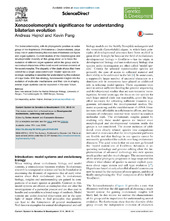| dc.contributor.author | Hejnol, Andreas | |
| dc.contributor.author | Pang, Kevin Scott | |
| dc.date.accessioned | 2017-04-05T08:34:49Z | |
| dc.date.available | 2017-04-05T08:34:49Z | |
| dc.date.issued | 2016-08 | |
| dc.Published | Current Opinion in Genetics and Development 2016, 39:48-54 | eng |
| dc.identifier.issn | 0959-437X | |
| dc.identifier.uri | https://hdl.handle.net/1956/15674 | |
| dc.description.abstract | The Xenacoelomorpha, with its phylogenetic position as sister group of the Nephrozoa (Protostomia + Deuterostomia), plays a key-role in understanding the evolution of bilaterian cell types and organ systems. Current studies of the morphological and developmental diversity of this group allow us to trace the evolution of different organ systems within the group and to reconstruct characters of the most recent common ancestor of Xenacoelomorpha. The disparity of the clade shows that there cannot be a single xenacoelomorph ‘model’ species and strategic sampling is essential for understanding the evolution of major traits. With this strategy, fundamental insights into the evolution of molecular mechanisms and their role in shaping animal organ systems can be expected in the near future. | en_US |
| dc.language.iso | eng | eng |
| dc.publisher | Elsevier | eng |
| dc.rights | Attribution CC BY | eng |
| dc.rights.uri | https://creativecommons.org/licenses/by/4.0/ | eng |
| dc.title | Xenacoelomorpha's significance for understanding bilaterian evolution | eng |
| dc.type | Journal article | eng |
| dc.type | Peer reviewed | eng |
| dc.date.updated | 2016-12-15T15:17:28Z | |
| dc.description.version | publishedVersion | |
| dc.rights.holder | Copyright 2016 the authors | eng |
| dc.identifier.doi | https://doi.org/10.1016/j.gde.2016.05.019 | |

